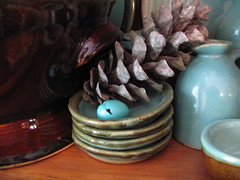
The yard has been a bird paradise this spring: several pair of cardinals in the lilacs, robins everywhere, some sort of grayish bird with a lovely warble (unless that is the wood thrush sound I remember from the pinewoods), and always chickadees flitting about. For two months we have been watching a mother robin carefully build her nest on the top of a porch column, safely tucked beneath the eave, and then tending her clutch. She started her nest in late April when we were in Kentucky and our friend Judy and daughter Addie watched her all that week--steady and determined, never faltering (and without too much disturbance from my brood to discourage her). In May she lay her eggs and they must have hatched in early June. For the past several weeks we have watched four chicks poke their noses up and now four sizeable bodies are jockeying for position—each looking like a small robin with a distinctive beak and hints of orange in their feathers. They have grown rapidly in only a few weeks and now seem too large for the nest. Soon they will fly and apparently one by one, on their own time.


My own children are still in the nest—two firmly in it and one teetering on the edge, shaking her wings and wanting to fly but not quite ready (nor am I, although there are times I would like to push her out of it). The robins sometimes poke at each other and then nestle in contented, just like my own children will do—like any siblings.

Apart from the mother robin sitting on the nest at night and plumping herself up to cover her chicks, like a great puff ball, we have observed the father darting in and out, often to relieve the mother during the day. Sometimes one swoops in with food followed immediately by the other. At the risk of making a sexist robin statement, he seems much slighter than his plumper mate. I’ve read a bit about robin behavior and it seems that the male will actually roost with the first clutch of chicks while the female is incubating a new brood. And, females are slightly less black so I may have been mixing our robins up! The plumper, brighter of the two may well be the male—and that is the one who is on the nest at night. As you can see from the photos, there are clear differences in markings and size.


Regardless of who is who, it is clear that the male helps feed the chicks and also helps care for them. I had never heard of a male bird helping his mate in this way, but I don’t know much about bird behavior. We’ve learned a lot about them observing them so close to our own lives. [And I know my own husband is as helpful around the house and with our children as this poppa robin seems to be.] But to observe this ritual, the give and take of the parents, and the bustle of their nursery, has been an extraordinary privilege. All of this activity while having a cautious trust of us, and our large bull mastiff dog, despite that their nest is on a column just over our side porch entry, the door that we use the most. The robins observe our comings and goings and family mayhem as we observe theirs.

Today while I gardened around the porch, I watched the mother and father come in and out with long fat worms or to tidy up, sometimes one right after the other, but neither lingering too long. They would more often watch from a nearby tree—perhaps coaching from a safe distance but likely to keep an eye on things while not hovering too close, like any good parent will do. The chicks are more alert now to sounds and motion and even try to catch a bug as it wafts around their nest. They are growing strong and sure and soon will be ready to live their bird lives and feather their own nests. I have grown quite fond of this little brood and I hope, somehow, they will know they can always come back home if they want and are able.

No comments:
Post a Comment